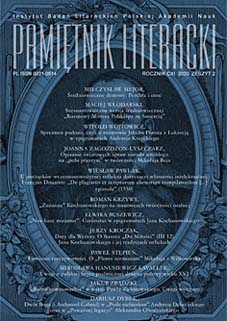Średniowieczne demony: Perchta i inne
Medieval Demons: Perchta (Berchta) and Others
Author(s): Mieczysław MejorSubject(s): Studies of Literature
Published by: Instytut Badań Literackich Polskiej Akademii Nauk
Keywords: medieval culture; medieval folklore; medieval demonology; Germanic mythology; Perchta
Summary/Abstract: Mutual relation of the culture of the intellectuals and of the folk one produced a “folkloristic culture” characteristic of the Middle Ages. The aforementioned culture was composed of pieces of both the high literate culture, and visual arts and stories transmitted orally. The world of folk imagery that remains in the sphere of common memory and, essentially, outside of the literate culture sphere is accessible to us only from cultural products and scanty written records. Preachers, inquisitors, and penitential writers focused their interest mainly on eradicating pagan beliefs and practices, thus in their descriptions failed to gain insights into them. Apart from that, pagan mythology and demonology survived only fragmentarily, due to, inter alia, inclusion of their elements into liturgical memory, Christian calendar-liturgical cycle, and also—to a greater degree—because belief in such creatures and their apotropaic rituals entered the rural folklore. In Germanic and adjacent countries a belief in the visit within the period of Twelve Days (i.e. from Christmas to Epiphany) of female demons, led by Perchta (Berchta), was spread. Perchta was a goddess having ambivalent features: sometimes a dangerous lamia, and sometimes a good-natured woman—a witch delivering presents to obedient children. In Polish culture, scarce evidence of the customs accompanying Twelve Days is an effect of a rare cultural osmosis connected with centuries-old immigration of Germans and with the spreading of the beliefs that the Germans brought with them.
Journal: Pamiętnik Literacki. Czasopismo kwartalne poświęcone historii i krytyce literatury polskiej
- Issue Year: 111/2020
- Issue No: 2
- Page Range: 7-28
- Page Count: 22
- Language: Polish

